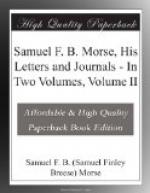That the recollections of his friends were probably clearer than his own on this point is admitted by Morse in the following letter:—
IRVING HOUSE,
NEW YORK, September 5, 1849.
My Dear Sir,—I was agreeably surprised this morning in conversing with Professor Renwick to find that he corroborates the fact you have mentioned in your “Sea Lions” respecting the earlier conception of my telegraph by me, than the date I had given, and which goes only so far back in my own recollection as 1832. Professor Renwick insists that immediately after Professor Dana’s lectures at the New York Athenaeum, I consulted with him on the subject of the velocity of electricity and in such a way as to indicate to him that I was contriving an electric telegraph. The consultation I remember, but I did not recollect the time. He will depose that it was before I went to Europe, after those lectures; now I went in 1829; this makes it almost certain that the impression you and Mrs. Cooper and your daughter had that I conversed with you on the subject in 1831 after my return from Italy is correct.
If you are still persuaded that this is so, your deposition before the Commission in this city to that fact will render me an incalculable service. I will cheerfully defray your expenses to and from the city if you will meet me here this week or beginning of next.
In haste, but with best respects to Mrs. Cooper and family,
I am, dear sir, as ever your friend and servant,
SAML. F. B. MORSE.
J. FENIMORE COOPER, ESQ.
All this is interesting, but, of course, has no direct bearing on the actual date of invention. It is more than probable that Morse did, while he was studying the French semaphores, and at an even earlier date, dream vaguely of the possibility of using electricity for conveying intelligence, and that he gave utterance among his intimates to these dreams; but the practical means of so utilizing this mysterious agent did not take shape in his mind until 1832. An inchoate vision of the possibility of using electricity is far different from an actual plan eventually elaborated into a commercial success.
Another extract from Mr. Habersham’s reminiscences, on a totally different subject, will be found interesting: “I have forgot to mention that one day, while in the Rue Surenne, I was studying from my own face reflected in a glass, as is often done by young artists, when I remarked how grand it would be if we could invent a method of fixing the image on the mirror. Professor Morse replied that he had thought of it while a pupil at Yale, and that Professor Silliman (I think) and himself had tried it with a wash of nitrate of silver on a piece of paper, but that, unfortunately, it made the lights dark and the shadows light, but that if they could be reversed, we should have a facsimile like India-ink drawings. Had they thought of using glass, as is now done, the daguerreotype would have been perhaps anticipated—certainly the photograph.”




